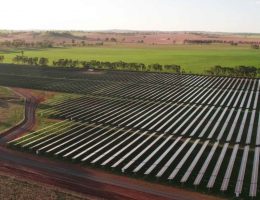Strong investment in renewable energy projects, and the impacts of severe drought conditions, have contributed to a 0.9 per cent fall in Australia’s greenhouse gas emissions for 2019.
The latest quarterly update to the National Greenhouse Gas Inventory published on Friday showed that emissions fell by 0.5 per cent in the last three months of 2019, driven by 40.7 per cent jump in solar generation, and a 1.7 per cent decline in coal power.
However, Australia’s fall in emissions still lags significantly behind the level of cuts needed to achieve the Morrison government’s even lacklustre 2030 abatement target.

Recently released energy statistics from the federal government showed that electricity produced from renewable energy sources overtook the market share for gas generation for the first time in 2019, as wind and solar set new records.
However, growth in Australia’s gas export industry has worked to offset some of the cuts achieved in the electricity sector, with fugitive emissions caused by escaped natural gas, growing a further 2.5 per cent in 2019.
Fugitive emissions from oil and gas extraction have more than doubled since 2013, driven by increases a massive ramp up in gas extraction and processing for export. Fugitive emissions now account for more than 10 per cent of Australia’s total emissions.

Climate Council senior researcher Tim Baxter said that the continued increases in greenhouse gas emissions from the gas sector further demonstrated that it did not offer a pathway to tackling climate change.
“Emissions from gas are rising, and they will continue to do so if our Federal government locks in new projects,” Baxter told RenewEconomy. “This temporary blip in emissions means nothing in the face of the continued growth of polluting gas.”
“Gas has no role to play in building a prosperous, resilient economy for the future. It is volatile, dangerous and unnecessary.”
A drop in agricultural emissions also partially accounted for the fall in 2019, which can be attributed to drought conditions that significantly impacted Australia’s sheep and cattle herd numbers.
A significant reduction in available feed has cut Australia’s meat livestock production and the added loss of around 600,000 cattle in floods impacting Queensland also early in the year contributed to the 5.8 per cent fall across 2019.
Federal energy and emissions reduction minister Angus Taylor said the latest figures reflected measures being undertaken by the Morrison government to cut emissions.
“When you compare our track record with similar export-oriented countries like Canada and New Zealand, we’ve done much better. Since 2005, Canada’s emissions have flatlined while New Zealand’s emissions have fallen less than 1 per cent,” Taylor said.
“Emissions are lower now than when the Coalition came into Government. They are more than 100 million tonnes lower in 2019 than Labor projected they would be in 2020 under their carbon tax.”
“Importantly, our domestic emissions have fallen at the same time demand for Australian energy exports remains strong, which will be vital to our post-COVID19 economic recovery,” Taylor added.
But, CEO of Farmers for Climate Action, Wendy Cohen said that it was wrong for the government to celebrate a fall in emissions given has been in a large part due to a bad year for farmers.
“The Federal Government is celebrating this slight dip in emissions without acknowledging that the shift is a result of a heart-breaking drought and a boom in renewables. This boom has now collapsed thanks to governmental policy inertia,” Cohen said.
“To rub salt into the wound they’re also championing investment in gas—a fossil fuel that massively pollutes at every stage of its operation. Emissions from Liquefied Natural Gas (LNG) are taking up an increasingly large proportion of our national emissions profile.”
The data shows that Australia’s greenhouse gas emissions are now 13.7 per cent below 2005 levels. It leaves Australia roughly half-way towards achieving the Morrison government’s emissions reduction target of 26 to 28 per cent by 2030.
However, the pace of these emissions reductions has slowed considerably under the Coalition government.
Emissions fell by a total of 14.8 per cent in the preceding six years, between 2007 and 2013, under the former Labor government, reversing a long trend of steady increases under the Howard government.
Australia’s emissions have fallen a total of 1.5 per cent in the six years since the Coalition formed government in 2013.
This virtual flatlining of Australia’s emissions under the Coalition raises questions around whether Australia is moving fast enough to cut its carbon pollution.
The Australia Institute’s climate and energy director Richie Merzian said that the Morrison government was still reliant on surplus Kyoto-era emissions permits to meet its 2030 target under the Paris Agreement, a plan that is legally baseless, and was roundly criticised by other countries at the most recent round of international climate talks held in Madrid.
“Emissions are not decreasing fast enough to meet our Paris target, and the Government is still relying on the leftover, and legally baseless Kyoto credits to get us across the line.”
“Electricity emissions are down because of clean energy policies and agencies the current Government tried its hardest to kill off when it came to power. Emissions in agriculture are down because of climate change related impacts through the drought and this is going to get worse if emissions don’t fall faster.”
“Increasing emissions from fossil fuel extraction is a major cause of concern and there is no evidence that Australia’s gas exports are reducing, not increasing global emissions. This will only get worse with a “gas-fired recovery”,” Merzian added.
The quarterly update included an initial assessment of changes in electricity consumption and transport fuel use for the first three months of 2020, with the beginnings of the impacts of Covid-19 related lock downs starting to take effect in March.
The update observed only a small impact on electricity demand and transport fuel consumption through March. However, preliminary early data suggests a larger impact throughout April, with electricity use down 2.8 per cent and transport fuel consumption down dramatically; with a 43 per cent decline in petrol use and 79 per cent decline in domestic aviation fuel use as movement restrictions came into force.
While the bushfires that impacted large parts of Australia over the most recent summer resulted in the release of a substantial amount of greenhouse gas emissions, they may have little impact on Australia’s official greenhouse gas accounts.
As the Australian government applies an averaging approach that accounts for both the emissions caused by fire, as well as emissions absorbed while the landscape recovers, the net change to Australia’s emissions is set to be small.
The next quarterly update to the greenhouse gas emissions inventory is due to be released by the end of August.
RenewEconomy and its sister sites One Step Off The Grid and The Driven will continue to publish throughout the Covid-19 crisis, posting good news about technology and project development, and holding government, regulators and business to account. But as the conference market evaporates, and some advertisers pull in their budgets, readers can help by making a voluntary donation here to help ensure we can continue to offer the service free of charge and to as wide an audience as possible. Thank you for your support.









